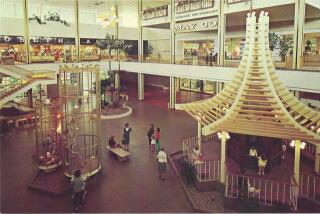Shopping Malls Go Academic : Renovation: Budget-crunched colleges capitalize on profitable student centers.
- Share via
ANN ARBOR, Mich. — The generation that grew up at the shopping mall now can find one right on campus.
Colleges, feeling a budget crunch, have been able to capitalize on student centers and turn what was a losing or break-even proposition into a cash cow.
Once synonymous with cafeteria food and rot-gut coffee, student centers now house mini-malls.
At the University of South Carolina, students can do their banking, shop for clothes, flowers, cards, drop off their dry cleaning, get a haircut, visit a travel agency and pick up tickets to local concerts and shows.
“Basically, we had a huge empty space in the heart of campus--very valuable real estate that we were letting go to waste,” said R. W. (Pete) Denton, senior vice president for business and finance at the university in Columbia, S.C.
As cuts in federal aid to education continued in the 1980s, other universities around the country realized that their student centers were not generating any income or, worse, they were losing money.
“And besides, this building was supposed to be the center of campus social life--the living room of the campus-based students--and it looked awful,” Denton said.
So Denton, like student union directors elsewhere, began to try to figure out what students wanted.
“We did market surveys. We did studies. But mostly we listened to the students,” he said.
What the students wanted turned out to be what many had experience hanging out in: shopping malls.
The university renovated 15,000 square feet in the centrally located University Union building at a cost of $350,000. Within three years of its 1985 opening, renovation costs were recovered. Now, the operation is producing $300,000 in revenues annually.
Colorado State University in Fort Collins had a money-losing student union when Manny Cunard became its director in 1983.
“It had a net loss of $250,000 and was in technical default,” he said.
Now, the union, which collects rents from the merchants--and a percentage of their profits--has an annual operating budget of $14 million and generates a surplus of $300,000, he said.
Does this mean that what’s good for the student union is good for the students?
At the University of Michigan, enterprising students set up a used textbook exchange that allowed cheaper books and better returns for students. Union mall merchants were not pleased.
The Barnes & Noble book outlet, unhappy with the competition, gave the university an ultimatum--banish the student book business or say goodby to Barnes & Noble, one student organizer said.
The student book exchange is now located in a cramped space in another building three blocks away.
Michigan Student Union director Frank Cianciola explained: For the amount of time the student book exchange “wanted to use it and the size of the space they wanted, it would have also conflicted with other student groups.”
Cianciola arrived at the Ann Arbor campus in 1980 to find in the basement of the Michigan Student Union a long-abandoned cafeteria and lots of empty space. Now the union has an annual operating budget of $6 million and profits of $150,000.
But Richard Blackburn, executive director of the Assn. of College Unions International, is concerned.
In his office two blocks from the student union at Indiana University in Bloomington, Blackburn said the requirement that unions be self-sustaining profit centers might overshadow the original educational role.
“They served as laboratories of citizenship for students,” said Blackburn, describing the unions as centers for student organizing and places for political as well as cultural activities.
“I think a balance has to be achieved between the commercial interests and the traditional educational role these buildings serve and I think that will be a problem.”
More to Read
Inside the business of entertainment
The Wide Shot brings you news, analysis and insights on everything from streaming wars to production — and what it all means for the future.
You may occasionally receive promotional content from the Los Angeles Times.










